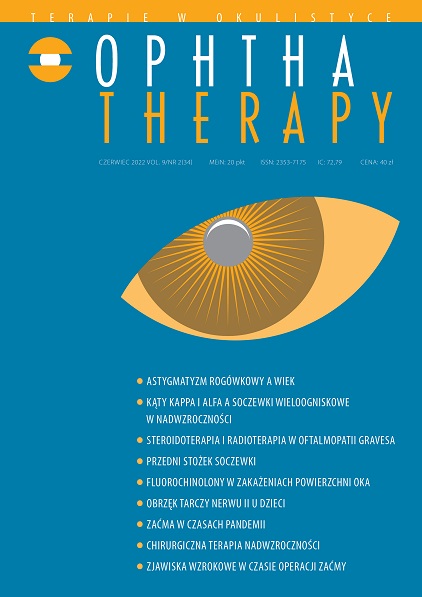Racjonalna terapia bakteryjnych zakażeń powierzchni oka z zastosowaniem fluorochinolonów Artykuł przeglądowy
##plugins.themes.bootstrap3.article.main##
Abstrakt
Prawidłowa powierzchnia oka ma szereg mechanizmów chroniących ją przed inwazją bakterii chorobotwórczych. W przypadku przełamania fizjologicznej bariery dochodzi do rozwoju zakażenia i stanu zapalnego. Jednymi z częstszych chorób zakaźnych powierzchni oka są bakteryjne zapalenia spojówek i rogówki. Terapia tych schorzeń powinna bazować na racjonalnym stosowaniu antybiotyków o szerokim spektrum działania przeciwbakteryjnego, wysoce skutecznych i bezpiecznych. Wszystkie powyższe cechy maja fluorochinolony: ofloksacyna, lewofloksacyna i moksyfloksacyna.
Pobrania
##plugins.themes.bootstrap3.article.details##

Utwór dostępny jest na licencji Creative Commons Uznanie autorstwa – Użycie niekomercyjne – Bez utworów zależnych 4.0 Międzynarodowe.
Copyright: © Medical Education sp. z o.o. License allowing third parties to copy and redistribute the material in any medium or format and to remix, transform, and build upon the material, provided the original work is properly cited and states its license.
Address reprint requests to: Medical Education, Marcin Kuźma (marcin.kuzma@mededu.pl)
Bibliografia
2. Azari AA, Barney NP. Conjunctivitis. JAMA. 2013; 310(16):1721-9.
3. Ting DSJ, Ho CS, Deshmukh R et al. Infectious keratitis: an update on epidemiology, causative microorganisms, risk factors, and antimicrobial resistance. Eye. 2021; 35: 1084-101.
4. Pippin MM, Le JK. Bacterial Conjunctivitis. StatPearls Publishing, 2022.
5. Blondeau JM, Zhao X, Hansen G et al. Mutant Prevention Concentrations of Fluoroqinolones for Clinical Isolates of Streptococcus pneumoniae. Antimicrob Agents Chemother. 2001; 45(2): 433-8.
6. Wagner RS, Abelson MB, Shapiro A et al. Evaluation of moxifloxacin, ciprofloxacin, gatifloxacin, ofloxacin, and levofloxacin concentration
in human conjunctival tissue. Arch Ophthalmol. 2005; 123: 182-3.
7. Yagci R, Oflu Y, Dincel A et al. Penetration of second-, third-, and fourth- generation of topical fluoroqinolone into aqueous and vitreous humour in a rabbit endophthalmitis model. Eye. 2007; 21: 990-4.
8. Oum BS, Kim NM, Lee JS et al. Effects of fluoroquinolone eye solutions without preservatives on human corneal epithelial cells in vitro. Ophthalmic Res. 2014; 51(4): 216-23.
9. Han KE, Chung WS, Kim TI et al. Epithelial wound healing after cataract surgery comparing two different topical fluoroqinolones. Yonsei Med J. 2014; 55(1): 197-202.
10. Tsai T, Chen W, Hu F. Comparison of fluoroqinolones: cytotoxicity on human corneal epithelial cells. Eye. 2010; 24; 909-17.
11. Lai WW, Chu KO, Chan KP et al. Differential aqueous and vitreous concentrations of moxifloxacin and ofloxacin after topical administration one hour before vitrectomy. Am J Ophthalmol. 2007; 144: 315-8.
12. Kowalski RP, Dhaliwal DK, Karenchak LM et al. Gatifloxacin and moxi oxacin: an in vitro susceptibility comparison to levofloxacin, ciprofloxacin and ofloxacin using bacterial keratitis isolates. Am J Ophthalmol. 2003; 136: 500-5.
13. Hanet MS, Jamart J, Chaves AP. Fluoroqinolones or fortified antibiotics for treating bacterial keratitis: systemic review and meta-analysis of comparative studies. Can J Ophthalmol. 2012; 47(6): 493-9.
14. Khoo P, Aguas MPC, Watson S. Comparison of combination forti ed antibiotics and monotherapy fluoroquinolone in the treatment of bacterial keratitis. Invest Ophthalmol Vis Sci. 2020; 61(7): 5216.
15. Haas W, Pillar CM, Torres M et al. Monitoring antibiotic resistance in ocular microorganisms: results from the Antibiotic Resistance Monitoring in Ocular microrganisms (ARMOR. 2009 surveillance study. Am J Ophthalmol. 2011; 152(4): 567-74.

